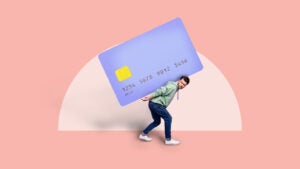U.S. credit card debt reaches all time high, exceeds $1 trillion

Key takeaways
- U.S. credit card debt increased by $45 billion from Q1 2023 to Q2 2023 leading to a new all-time high.
- Nearly 50% of cardholders carry debt from month-to-month, up from 39% in 2021.
- Rising figure shows a strong consumer economy and lower reliance on cash.
The total U.S. consumer credit card debt has risen to an all-time high of $1.03 trillion in Q2 2023, according to the Federal Reserve Bank of New York’s Center for Microeconomic Data. The Fed issued its Quarterly Report on Household Debt and Credit, which tracks various U.S. household debt, including mortgage balances, credit card debt, auto loan balances and consumer loans.
According to the report, U.S. credit card debt increased by $45 billion from Q1 2023 to Q2 2023, swelling from $986 billion to the new high. The number of credit card accounts also grew by 5.48 million, with 578.35 million card accounts now open in the U.S.
This debt amount is a drastic swing from just a few years ago when consumer protections and consumer spending changes during the pandemic led to a large drop in average credit card balances.
“Balances are up 34% from the pandemic low of $770 billion in Q1 2021,” says Ted Rossman, Senior Industry Analyst at Bankrate. “Bankrate recently found that 47% of credit cardholders carry debt from month to month, up from 39% in 2021. Even more troubling is the fact that 60% of Americans with credit card debt have had it for at least a year, up 10 percentage points from two years ago.”
While record-high credit card debt sounds alarming, Rossman carefully notes that the new $1.03 trillion figure doesn’t necessarily mean all consumers are in trouble.
“Just over half of cardholders avoid interest by paying in full each month, so credit cards are working for them, in terms of rewards and buyer protections,” says Rossman. “Rising credit card balances are also good for the economy in the sense that consumer spending powers about 70% of economic growth. Credit card balances are also rising in part due to population growth and because cash usage continues to decline.”
What to do if you’re facing credit card debt
If you’re facing credit card debt that’s negatively impacting your finances, you have a few options to help relieve that pressure and get yourself back on track to good financial health.
“My top tip for paying down credit card debt is to sign up for a 0% balance transfer credit card,” advises Rossman. These cards can offer the opportunity to pay down your debt interest-free for anywhere from nine to 21 months, and can help you save big on interest, despite balance transfer fees.
Other debt payment strategies, like the debt snowball and debt avalanche, can also give you a clear step-by-step approach to chipping away at your debt.
The bottom line
Consumer credit card debt may be on the rise, but strong consumer spending and healthy credit card repayment habits on the part of consumers suggest this may be a natural part of our growing economy.
Take care to pay your balance in full at the end of each billing cycle to make credit cards a useful tool in your wallet, not a financial hindrance.






